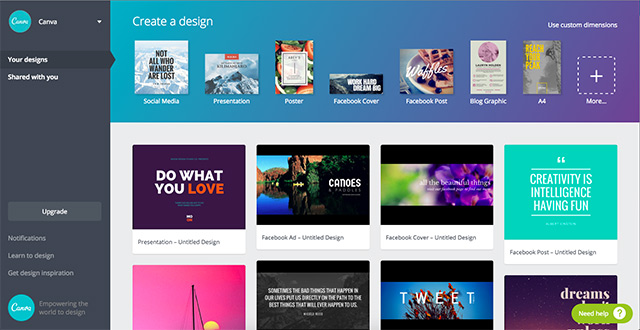When it comes to creativity and originality, you can’t beat the real deal. Hiring a graphic designer is the way to go, but what if you can’t afford it?
Just because you’re not a professional designer doesn’t mean you don’t have the capacity and the ability to make your media look better. What it takes is some time and effort to learn, mixed in with a healthy dash of bravery to believe in your ability.


A quick tutorial for non-designers
If you aren’t a designer, but need to hack it on your own for now, you need some guidance. Here is a simple tutorial for non-designers, including tips and tools to help you out:
1. Get inspired
Think about designs that you like – inspiration can come from anywhere! Take note of an email or website that grabbed your attention and what you liked about it. Don’t just look for design inspiration within your field, you can look at ads or websites for products or services that are completely different from what you do, and often these lead to the most innovative and striking arrangements of images and text.
If you’re stuck, don’t just sit there and stare at a blank screen, but look out into the world for something that sparks your imagination. Keep track of things that make you go “wow” by logging them into a spreadsheet, pinning them to a board on Pinterest or bookmarking them. At times when you feel at a loss you’ll be able to go back to those points of inspiration and get rolling again.
Assignment: Find five sources of inspiration and enter them into your chosen tracking method. Remember that this is a necessary beginning. We learn design primarily by observation when we’re just starting out.
2. Keep it simple
Design that’s clean and easy on the eyes gets the message across more effectively than design that’s full to the brim with extras. Focus your message by being as clear as possible. Don’t use an overabundance of colors and do not use more than two fonts, otherwise the point will be lost in the chaos.
Don’t fear whitespace – it is perfectly ok, and in fact it’s preferable, to have it. Realize that the brain can only process so much information at one time, so avoid clutter. Eliminate what’s not necessary and give your designs room to breathe.
Assignment: Flip through a magazine and pay attention to which pages catch your attention best and are easiest for your brain to decode. Notice that simple, clean images are easier on the eyes and get the point across more effectively than text and font heavy ads.
3. Get off-center
Don’t stay stuck in the middle of the page. Non-designers have a tendency to want to center everything, which isn’t necessary and in fact is rather uninteresting to look at. Remember, people read from left to right, and so the eyes naturally follow that pattern no matter what kind of information is in front of them – text or images.
Assignment: Grab a pen and paper, then doodle. First, draw a circle with a happy face inside right in the middle of the paper, taking up about a quarter of the total space on the page. Write some text around it – it doesn’t matter what the text is or the pattern of the words. Now grab another sheet and draw your large, quarter page circle smiley face in the bottom right, then write your text in rows starting at the top right. Which is more natural? Feel free to experiment with other smiley face placements to explore how your reaction changes with differences in text arrangement and image placement.
4. Consistency is key
Unification of message is a big deal in branding and design. People connect to familiarity. Stick with one color scheme and set of fonts and stick with them everywhere. That means in emails, ads, on your social media, everywhere. Don’t randomly change your color scheme or fonts, only make those kinds of changes if you’re doing an intentional re-branding of your business.
Assignment: Think about your favorite brands – what are the colors and fonts associate with them? Now realize how quickly you connected the graphic design with the company and how important it is for you to mimic that in order to be effective.
Design Tools for non-designers

Perhaps the biggest hurdle for non-designers isn’t coming up with wonderfully compelling designs, it’s figuring out how to use complicated design software. First off, realize that modern graphic design software is accessible and easy to use for people who have little experience with it. If you know how to click a mouse then you can use current design software to get things done. Do realize that there is still a learning curve when it comes to figuring out these programs and that you have a good bit of trial and error in front of you even with a simple design program.
When people do think of design programs, they immediately think of expensive software. While there is some amazing software out there to download, there are also some other solid programs that you have out there that you have at your disposal online, most of which are free or low-cost. If you’re working to hack your graphic design, then test drive one of these free alternatives below.
NB: If you’re wanting to go straight to pro, go for Adobe CC (Photoshop, Illustrator, etc). They offer a free 30 day trial and there is a great course at the bottom of this article.
Google Drawings
This is really the first baby step into graphic design. If you have NEVER opened an image editing program before but have written a text document, then the familiar layout of Google Drawings will help you to get into the swing of it. Find it right on Google Drive. This is a perfect place to toy around with the basics.
Infogr.am
If you’re wanting to created infographics, then this is the design program for you. With a wide variety of predetermined layouts and formats, a great deal of the work is already done for you on Infogr.am. You don’t have to do a great deal of work here in order to create some really stunning infographics. Again, this is a great place to start!
Canva
For the next step, try Canva. This service uses simple templates to help you figure out where to begin, then offers a user friendly interface that is accessible to even novice graphic designers. There are just a few options offered for each tool, with further variations underneath as you become more comfortable.
Picmonkey
With Picmonkey you’ll find everything you need to tune up pictures, create collages and even design from whole cloth. The controls are so easy to use, and the whole process is incredibly intuitive. There are wonderful themes that you can use to immediately upgrade or change the color scheme and other design elements, a perfect way for those who are new to graphic design to make sweeping changes.
Assignment: Choose one of these programs and test out designing one of your doodles from step 3. Then try it out in a different program to compare your experience.
Non-Designers can make it work
In a world that’s flooded with a plethora of images, more and more non-designers are jumping in and creating beautiful and compelling content. While it’s definitely preferable to hire a graphic designer to bring professional quality work your project, non-designers can definitely make it work in the meantime. The key is being open to learning and experimentation.
There’s something incredibly satisfying about bringing an idea to life through images – you might well find yourself hooked on design!
Graphic Design for Beginners Online Course
If you’re wanting to learn professional design programs check out this Design Bootcamp on Udemy that teaches you the basics of Photoshop, Illustrator, and InDesign. It includes 7.5 hours of video content over 61 lectures.

Enroll in Beginners Design Course.
—
Michael Georgiou is the CMO and Co-founder of Imaginovation, a full service, turn-key digital solutions company serving Raleigh, NC and Charlotte, NC. Follow him on Twitter at @MGeorgiou22.
This article really is useful as most it encourages more people to venture into designing without the knowledge of core graphic design skills.
Nice layout of your articles too, I truly am a fan of your blog. Keep it up Jacob.
Thanks Terry and thanks for following too.
I am wanting to go to school for Graphic Design but $ are not available right now. I am doing a portfolio of my own work.